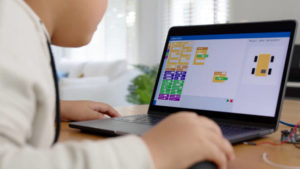32 Game-based STEM Learning for Kids
STEM education plays a crucial role in developing the next generation of critical thinkers and innovators. There are lots of games you can play and experiments you can do to better understand the world through science, technology, engineering, and math.
The sooner you start learning, the farther you’ll be able to go… You’ll have a head start on success!

STEM Experts Who Can Make a Difference are Being Prepared
STEM education equips students with skills that make them more employable and prepared to fulfill current labor demands. It includes a wide range of experiences and skills. Each STEM component contributes significantly to a well-rounded education.
- Science teaches students an in-depth understanding of the world around them. It assists them in improving their research and critical thinking skills.
- Technology educates young people to work in a high-tech setting full of advancements.
- Engineering allows students to improve their problem-solving abilities and use their knowledge in new projects.
- When designing solutions, Mathematics allows people to assess information, eliminate errors, and make conscious decisions.
STEM education integrates various disciplines into a unified whole. As a result, it trains professionals who can improve society through innovation and long-term solutions.
Along with foundational disciplines, the STEM approach to education develops creativity and divergent thinking. It stimulates and motivates young people to develop new technology and concepts.
Students benefit from inquiry-based assignments that emphasize practice and invention. STEM education helps students understand topics and encourages them to use their knowledge.
To summarize, its goal may be summed up in two simple actions: discovery and experience. In a risk-free setting, students are free to put what they’ve learned into practice and welcome failures.
Project-based learning and problem-solving assist students in developing a unique worldview. Its foundation is built on adaptability and curiosity, which prepares students to respond to real-world issues.
The Importance of Game-based STEM Learning for Kids
Games are already pervasive.
Four out of every five American households now have a gaming gadget. It’s great to see how game-based learning transforms learning in and out of the classroom and keeps youngsters engaged.

STEM Games prepare students for future careers in the STEM fields.
The problem-solving skills necessary in STEM occupations are strikingly similar to those cultivated by gaming.
One thing to keep in mind is that those challenges do not go away for persons facing problems in STEM fields; they are not like textbooks that you can close and then walk home with.
When presented with a dilemma, you need to be immersed in solving it, and games provide that immersive chance for problem-solving that you cannot mimic anywhere else.
Kids like the “hard fun” of gaming.
Game designers use the term “hard fun” to characterize experiences that are both pleasurable and demanding. That is why children play games in general, whether video games, basketball, or chess. Children are having fun while also completing complex tasks.
Games encourage a growth mindset.
Everyone in a game is capable of completing a level and progressing in the game. The awareness that intelligence is not a fixed trait and that anyone can learn and grow is a growth mindset. Having a growth attitude in math is the only way we’ll be able to get our kids to the next level.
STEM-Based Games
Alice.org
Here’s a free three-dimensional tool that allows users to create a tale animation, a game, or share a movie. The site’s adviser, who resembles Alice from Alice in Wonderland, assists students in developing their visual masterpieces.
Science Kids
Science Kids offers educators and children interested in science and technology instructional resources and interactive games and activities. Experiments, games, facts, quizzes, projects, lessons, photos, and more await visitors.
MathMovesU
The site, developed for middle-school pupils, tries to keep mathematics alive by integrating activities with children’s interests. Users can build their own avatars and play games, learn about mathematics, and take surveys and quizzes. Parents and teachers can join the “Math Hero” rewards program to access math worksheets, teaching guidelines, and other resources.
CSI – Web Adventures
Visitors to this interactive Website can use forensics to solve crimes at the beginning, intermediate, and advanced levels. Other activities on the site include handwriting analysis, a detective game, and learning about various science jobs.
Engineer Girl
Engineer Girl inspires young middle-school females to seek science, technology, engineering, and mathematics (STEM) jobs. Girls can “try on a job,” talk to real-life professional engineers, play games and surveys, apply for scholarships, and more.
Discovering Engineering
The objective of Discover E is to promote and grow the engineering profession via outreach, education, and volunteerism. The website outlines what engineering is and what professional options one can choose. It also provides instructive films and games.
Heatwave Antarctica
Heatwave Antarctica is a science-based game that uses the states of matter to solve puzzles. Can you survive the heat?
Extract DNA
DNA is the building block of all life, and you can actually see some for yourself by doing an experiment with spinach using basic household items.
Try This Mini-Catapult
Engineer Girl provides the plans to build a classic siege machine. You’ll learn about gravity and the strength of stored energy once you build this machine.
Scratch
The Massachusetts Institute of Technology (MIT) hosts this tool that teaches the basics of coding.
Egg Drop Project
The principles of gravity and force are explored with this engineering challenge. Try building different devices to see which one best protects the egg.
Make Your Own Volcano
Building a volcano is a classic science fair project. Take your experiment a step further by doing things like adding vinegar at different temperatures and recording how that changes the reaction that leads to the volcanic eruption.
Seismic Shakeup
Try to build a structure that can withstand an earthquake, then test it on a shake table. The shake table can be easily built at home and reused for other projects.
Pages of Inertia
This experiment by Bill Nye the Science Guy teaches you about inertia using nothing but your hands and a very thick book.
Blockly Maze
BrainPOP offers this maze game that teaches basic ideas about computer coding in a fun way.
Clickety-Clackety Coin Experiment
A plastic soda bottle, water, and a quarter are all that’s needed for this quick, fun experiment with temperature and density.
Coding Challenges
A variety of challenges can teach you to how to use code to convert minutes into seconds, convert ages in years into ages in days, and solve other types of problems.
35 Fun DIY Engineering Projects for Kids
These 35 projects include ideas for kids of all ages, from young children all the way up to teenagers.
Balloon Car Activity
A balloon powers this easy-to-make car. Build two and race them with a friend!
15 Backyard Engineering Projects for Kids
These projects are good for a wide range of ages and skill levels, but they’re all fun and can teach you about science and engineering.
STEM Learning: Mars Perseverance Parachute Coding Activity
The parachute that slowed Perseverance’s descent onto the surface of Mars was encoded with a secret message. Can you figure it out?
Design Your Own Marble Run (video)
This video shows how to construct a marble run. You can learn about force, gravity, mass, inertia, and other principles by building your own marble run and then racing marbles through it!
Soil Quest
Soil is the basic foundation for all life on our planet. This quest asks you to help protect our soil.
Paper Airplane Design
Paper airplanes can be designed in a variety of ways, and each design has its own benefits and drawbacks. Experiment by folding different types of airplanes to see which ones fly the farthest.
Smithsonian Learning Lab
The Smithsonian Learning Lab is a free resource that provides tools that let students create projects and upload them to share with others.
Static Electricity
Georgia Power, a utility company, put together this experiment that teaches kids about static electricity.
Life of a Can
Learn about the life cycle of a can and how you can make it longer by recycling your cans instead of throwing them away.
Nature Scavenger Hunt
Print out this nature scavenger hunt and use it to learn how to identify different things you see outside. You could even challenge a friend to go for a walk with you and see who can find the most things on their sheet.
Create a Monarch Waystation
You can help butterflies by planting food sources for them, and you can also watch for them and collect data on how many you see and when you see them to practice skills that scientists and engineers use all the time.
Boonshoft at Home
The Boonshoft Museum has a whole bunch of STEM activity ideas that kids can do at home, from building straw rockets to making homemade slime.
Science at Home
The Brookhaven National Laboratory offers scientific activities for kids, and the Discover Brookhaven Challenge lets you earn a certificate for doing some.
The Asheville Museum of Science: Daily Activities
This science museum offers virtual daily activities that focus on biology, astronomy, paleontology, physics, engineering, and robotics.
